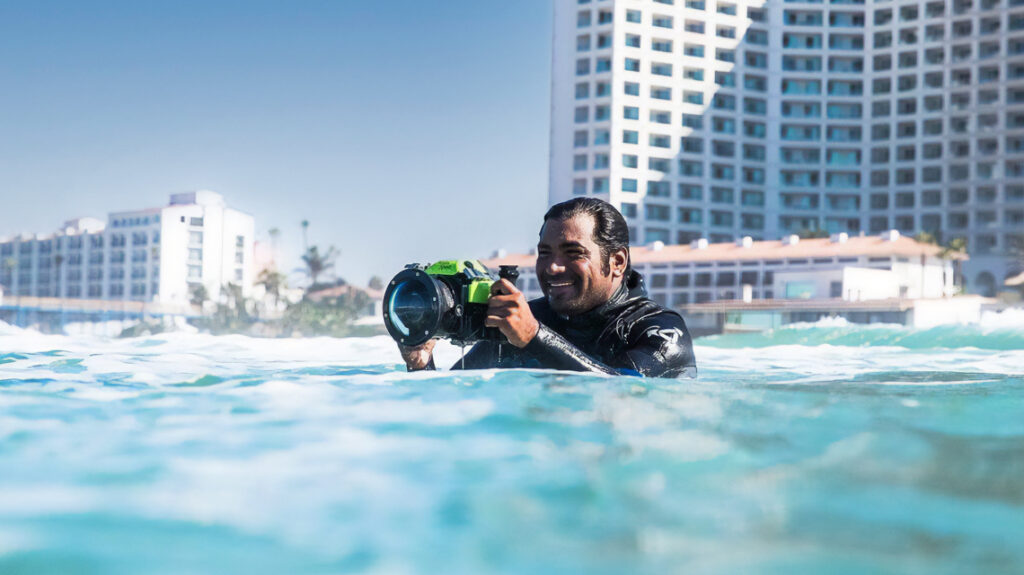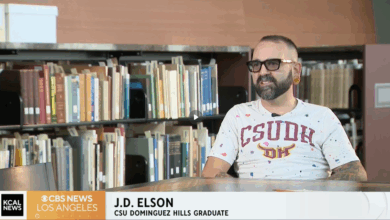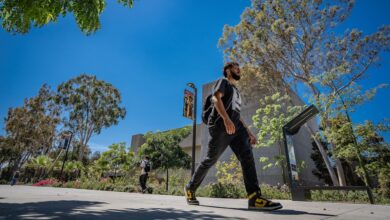
When Johnny Gonzales was a student in CSUDH’s Television Arts program, the topic for his student film was an easy choice. An aspiring water photographer, he decided to focus his lens on his intrepid colleagues who spent their days in the ocean, shooting action shots of surfers and bodyboarders.
“I really wanted to tell their story,” says Gonzales. “Most people don’t quite get it–they have no idea what goes into getting great surf photos, and what it takes to get the perfect shot. I feel like water photographers are the unsung heroes of the surfing world.”
The resulting 9-minute student film, “Surf Photography: The Watermen,” produced with fellow students Jon Domingo and Cynthia Gutierrez, turned a lot of heads. The film was awarded the Gold Remi, the top award in the “college student” category at the 50th Annual Worldfest Houston International Independent Film Festival, the world’s largest festival of its kind.
The film also took home the Best Student Documentary prize at the Student World Awards, and first place in the “Creative” category at CSUDH’s Student Research Day. Its success inspired Gonzales to continue working on it after graduating in 2017 with a BA in Digital Media Arts: Television Arts. “I knew the story was good, and I wanted to expand it beyond the local photographers I had originally shot,” he says.
Gonzales spent the next four years working on the project, taking time off between photography gigs to travel to well-known surfing hotspots like Hawaii and Mexico–and lesser-known scenes in England and Ireland. The resulting documentary feature, In the Water; Behind the Lens, is a fascinating behind-the-scenes look at what goes into capturing world-class photos of top surfers and bodyboarders.
Critics and audiences have taken notice. Gonzales’ documentary was accepted to several film festivals in 2021, winning the Best Feature Documentary Award at the San Francisco Frozen Film Festival and the Audience Award for Best Action Sports Film at the Newport Beach Film Festival. It was also an official selection at the Paris Independent Film Festival, New York Lift-Off Film Festival, Sarasota Film Festival, and Catalina Film Festival. In the Water; Behind the Lens also aired on PBS stations throughout July 2022.
The film was largely a labor of love for Gonzales, who grew up in Los Alamitos, Calif., and spent his days bodyboarding at Seal Beach and Huntington Beach. He funded the project himself, and also served as director, camera operator, and editor.
“Whenever I finished a good-paying job, I’d be off to England or Mexico to film,” he remembers. “I would film on the beach and hustle interviews, then come home broke and have to earn some money again.”
Although he initially tried to obtain outside financing, producing the film himself ended up having some positive consequences. “The cool thing is that nobody could tell me how to do it,” he says. “If you’re working for other people or big studios, they can start to tell you what to do and how to do it. Working independently means nobody could tell me anything. This is my vision.”
Gonzales managed to land interviews with a who’s-who of water photographers, including Dan Merkel, Jeff Divine, Jim Russi, Krista Funk, and Maria Fernanda. They help trace the history of water and surf photography–from the early days of clunky cameras and 36-exposure film rolls to today’s high-end digital cameras and Instagram feeds.
The rise of social media is one of the underlying themes throughout the film–it has changed the industry from top to bottom. “That’s one of the reasons I wanted to get into film,” says Gonzales. “It’s hard to make money as a surf photographer these days. Everyone throws everything on Instagram. Nobody’s paying for these water shots anymore.”
During the heyday of surf photography in the 1970s and 1980s, “Top photographers made big money,” says Gonzales. “Dan Merkel would have his travel expenses and everything paid for, and would come home to a stack of checks for thousands of dollars. Now the big companies want all the photos for free. The game has completely changed.”
The dangers that water photographers face is also addressed–from sharks or surfers running into them to the inherent risks of the ocean itself. To illustrate the point, Gonzales includes harrowing footage of champion bodyboarder Andre Botha rescuing a surfer who was knocked unconscious when he hit an underwater reef.
“It’s kind of gnarly to see,” says Gonzales. “He’s blue in the face, foaming at the mouth. I cut it before it got too graphic, because that was upsetting.” The injured surfer fully recovered, but the footage provides a startling reminder of how dangerous big waves and ocean currents can be.
As Gonzales’ film shows, there is a strong bond between the surfers and the photographers who capture their acrobatics. “We’re all out there together,” he says. “We go where they go. And they want good photos, their sponsors want good photos. They really appreciate the good photographers out there. They love us and we love them!”
Gonzales’ film also includes many of the most iconic surfing images ever captured–many of the photographers he interviewed allowed him to comb their vast archives. “I kind of got lucky,” says Gonzales. “Some people like Dan Merkel let me use whatever photos I wanted. In the end, I had to get 42 releases signed, and they were all really cool about it.”
After the success of In the Water; Behind the Lens, Gonzales is currently deciding what his next film project will be. “You’ve got to strike while the iron is hot,” he says. “But I don’t want to rush into anything. I want it to be something I’m passionate about.”
For now, though, he’s enjoying the exposure that his one-time student project has gotten. “It’s a tough game out there,” says Gonzales. “But I’m really proud of my film and am excited that people are watching it and responding so positively. It’s been a really cool experience.”
In the Water; Behind the Lens is available to rent or buy at www.oceansproductions.com. It is currently available for streaming at https://www.pbssocal.org/shows/water-behind-lens.









